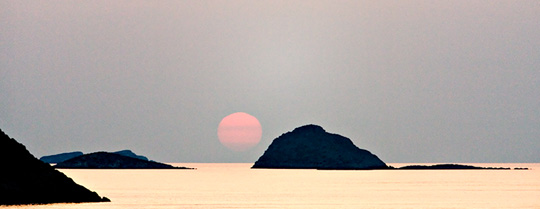
Aegean Sunrise #1. Greece, 2005
Canon 5D with 70-300mm f/5.6 DO IS lens @ ISO 1250
September, 2005
First things first. This isnota test report. The Canon 5D was announced in late August, and about a week later I received a pre-production sample camera from Canon for field testing. This fortunately coincided with my departure a couple of days later for a two week trip to Athens, Istanbul and the islands of the Aegean Sea. The timing couldn’t have worked out better for a real-world test experience.
Since the camera in hand was not a full production camera (these are coming in October) I will not be spending time looking at nitty-gritty image quality issues. This will have to wait for production cameras. My concerns in this report will be how the camera handles, performs in general, and where it fits in the spectrum of currently available DSLRs.
In the meantime if you feel the need to know how every button and knob works, and wish to peruse the technical specifications of the camera in detail, you may refer to the comprehensiveDPreview preview report.
___________________________________________________________
In Hand

In case you haven’t been paying attention, the Canon 5D is a 12.8 Megapixel DSLR with a full-frame 35mm sensor priced at around $3,000. It joins the 16 Megapixel Canon 1Ds MKII as only the second full-frame DSLR currently available. The ill-fated Kodak DCS 14n and Pro n models, in both Nikon and Canon lens mounts, have been discontinued.
But, what makes the 5D of special note in today’s camera marketplace is not so much that it’s full-frame, and not that it’s just shy of 13 Megapixel – though both are very desirable traits. What makes the 5D of singular interest is that the camera’s size and weight is little bigger than that of its stablemate, the Canon 20D, as well as most of the other current 5-8 Megapixel DSLRs with reduced-frame (APS-sized) sensors.
Till now, full frame cameras have been large, bulky and heavy. In the case of the Canon 1Ds and 1Ds MKII they are built like the proverbial brick outhouse, but when you carry one of these around all day you know it. Because of their size these are also not the most discrete cameras to shoot with. They shout "pro", which in many situations isn’t that desirable.
Pick up the 5D though, and until you put it up to your eye you might be tempted to think that it’s simply a 20D with a slightly overactive thyroid. It might as easily be a typical consumer DSLR. So if impressing your photo buddies with the size of your tool (sorry about that) is what you have in mind, then the 5D will disappoint. But if you want to shoot discreetly, and with a camera that won’t strain the wrist after a half hour, then the 5D will definitely attract your attention.
What will also attract you, if you’ve been lusting after a full frame 1Ds or 1Ds MKII over the past few years, is the 5D’s price. With a list price of US $3,299, and a likely street price before the end of the year of under $3,000, the 5D is only about 45% of the price of a 1Ds MKII. Though still expensive in most people’s books, for pros and advanced amateurs wanting a high-resolution full frame camera the price of admission has just been chopped by more than half.
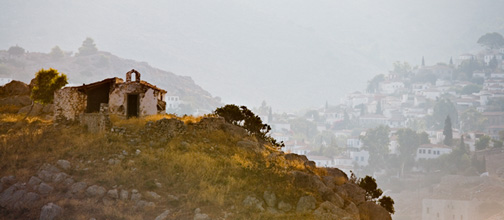
Hydra. Greece – September, 2005
Canon 5D with 70-300mm f/5.6 DO IS lens @ ISO 160
___________________________________________________________
The Viewfinder
Hand a new camera to a photographer and the first thing that he’ll do is put it up to his eye. It’s a reflex (no pun intended). For photographers who have never looked though the viewfinder of a film SLR, or a 1 Series Canon, the first response when looking through the 5D will be to ask –Who turned on the lights? Now the reason for the added bulk of the 5D over the 20D becomes apparent. It’s caused by the larger mirror and larger prism, both of which contribute to a vastly brighter and larger viewfinder image.
To my mind this is possibly one of the most appealing traits of the 5D for photographers who have become used to the dimmer and smaller viewfinders of most current DSLRs. Some who are enamoured ofpixel peepingwill focus their interest and concerns on pixel count, noise issues and the like.Photographersthough (with a capital P) will find themselves taken with the visual stimulation and clear shooting advantages of a large and bright viewfinder.
Along with the bigger prism and mirror comes the ability to interchange focusing screens. For many applications, including macro work, architectural, astrophotography, and use of non-Canon EOS mount lenses via adaptors, etc., an alternative screen is very handy, and in some cases a necessity. A removable prism is now a thing of the past in 35mm. This feature therefore remains only on select medium format cameras. Interchangeable focusing screens though have always been a hallmark of cameras aimed at the professional user, as they are rarely used by beginners, and their inclusion increases manufacturing costs.
I’ve heard some discussion about the fact that the 5D’s viewfinder only covers 96% of the image area, while that on the 1Ds MKII is essentially 100%. This is not a big deal. Historically most film cameras only showed 95% or so because slide mounts and negative carriers masked the remainder, and by using a slightly smaller prism bulk can be reduced with almost no impact on viewfinder brightness. (Glass prisms are heavy, and represent a large percentage of the weight of an SLR). You did say that you wanted light weight along with a bright viewfinder – didn’t you?
___________________________________________________________
No Flash?
Unlike the Canon 20D and Rebel XT, the 5D does not have a built-in pop-up flash. Some folks on the discussions forums have focused on this, and the debates range on as to the reasons why, as well as pros and cons.
Here’s my take. There are pro cameras with built in flash, and pro cameras without. The Hasselblad H1 and H2, for example, have built-in pop up flash, and if these aren’t pro cameras I don’t know what is.
Do pros use built-in flash units? Of course they do. There are situations where these can come in handy for any photographer. Naturally a stand-alone flash unit has advantages, but the nice thing about a pop-up is that you never forget it at home.
One also needs to understand that the smaller prisms found on reduced frame cameras like the 20D make it easy to build in a pop-up flash. The 5D’s full-size prism doesn’t leave room for one, and so the Canon 1 Series, and now 5D camera, don’t feature pop-up flash. It’s as simple as that.
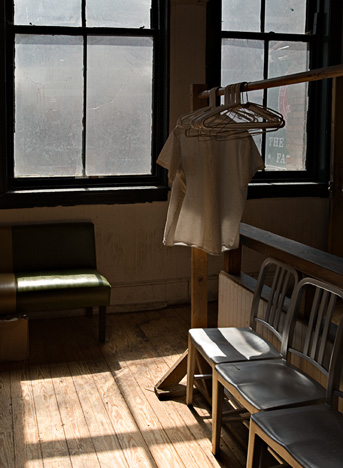
Hangers. New York. September, 2005
Canon 5D with 16-35mm f/2.8L lens at ISO 400
___________________________________________________________
Compared to a 1Ds MKII
So – what does the extra $4,000+ that the 1Ds MKII commands provide over the 5D? Obviously, a 16MP sensor, and most noticeably significantly improved weather sealing and ruggedness of construction. It’s actually worth a moment’s digression though to explore this topic, because during the first few weeks after the 5D’s announcement there has been a lot of speculation on this issue.
One online wag went so far as to label the 5D "leaky". Well, that’s obviously adolescent posturing. What is the real story on weather sealing?
All I can offer is anecdotal evidence from my 35+ years as a photographer, having worked in conditions ranging from the jungles of Africa, to the Arctic of Canada, and deserts of the American Southwest; from rainstorms, to blizzards, to dust storms, and in temperatures ranging for -40C to +40C. In all that time I have never had a camera fail completely because of dust, moisture, heat or cold.
Well – a Rollei 6008 once stopped working briefly after I’d walked under a waterfall with it, and it needed to be dried out under the hot air of a gas station washroom’s hand dryer before it came back to life. I also once had a Leica M3 stop shooting after I worked an Olympic event during a thunderstorm for 2 solid hours. I let it air dry overnight and it was then none the worse for wear. A Nikon F2 literally froze-up while I was shooting a ski race in near blizzard conditions, but was fine once it thawed out. These are the only casualties after thousands of days of shooting all over the world over many decades with a huge range of cameras.
The Canon 5D is a typical prosumer camera in terms of weather sealing and build quality. I would therefore expect that photographers will be able to shoot in conditions where the photographer will give up long before the camera does.
I’m reminded of a situation on one of my recent workshops where we were shooting on an at-first misty and then quite rainy early morning. As the mist and fog turned to rain one of the workshop members went back to the protection of the car, and packed away his camera. I went over and asked if he was OK. His response was that he was fine, but that he was concerned about his camera getting wet. I said if he thought that a bit of rain was endangering his camera, he was mistaken, and I urged him to return to where the rest of the group was working in the rain. He did so reluctantly, and then later in the day when he saw that his camera was still working fine he thanked me, because he said that in the past he’d never gone out shooting when it was even threatening rain for fear of damaging his camera. He said that this new-found realization was worth the price of the workshop!
So, if most cameras are tougher than most photographers, why does one pay a premium for pro series cameras with extra weather sealing? Part of the reason is that some pros, such as photojournalists, subject their cameras to very rough environments, not just now and then, but regularly. They may find themselves working in highly adverse conditions for days and often weeks at a time. This is where the superior weather sealing and ultra-rugged build quality of a top-of-the line pro camera really pays off.
There are of course technical features which also differentiate a 1 Series camera body from that of the 5D. These includes high shooting rates, larger and higher capacity batteries, superior autofocus capability, and the like. You can easily determine which of these capabilities are important to your type of shooting and decide whether the financial equation makes them worthwhile. There will be endless (and to my mind pointless) debates over whether or not a 1Ds MKII is worth the additional money, but my sense is that most of the debaters will likely never have used either of them. Just the usual brand tribalism and posturing.
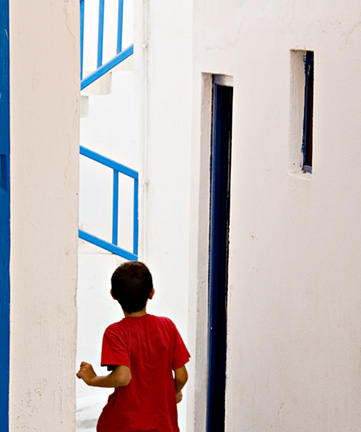
Santorini Laneway – September, 2005
Canon 5D with 70-300mm f/5.6 DO IS lens @ ISO 400
___________________________________________________________
Interface
A camera’s user interface is possibly one of the most critical aspects influencing its usefulness. While most amateurs concentrate their concerns and attention on image quality minutia, pros know that all current cameras are capable of producing excellent images, usually limited just by the photographer’s skills and eye. For the working pro though, how a camera falls to hand, how easy or difficult it is to accomplish required settings quickly, and how easy it might be to make them inadvertently are primary considerations.
Canon’s cameras fall into two groupings when it comes to user interface – the 1D Series and all the rest. 1 Series cameras are designed so that no settings can be made by accident. Handle the camera as roughly as you may, nothing will be misadjusted because a gloved hand, for example, brushed against controls and you ended up shooting in extremely low light at ISO 100, or tracking a bird in flight with focus mode accidentally shifted to single frame. (Lens controls are another matter, but not relevant to this discussion).
That’s the good news about 1 Series Canons. It doesn’t let you make a mistake. The bad news is that making settings quickly is slowed by the requirement that everything takes at least two button presses to accomplish, and sometimes more.
Canon’s current "lesser" cameras, the Rebel XT, 20D, and the subject of this report, the 5D, use a completely different user interface design paradigm, and this is both a blessing and a curse. Settings with the 5D and its brethren can be made much more quickly than with a 1 Series. Press, turn and you’re done. But, this also means that its easier to make a setting change by mistake.
Not to make too big a deal of it, but the one area where I feel that Canon has fallen down in the 5D’s design is with regard to the shooting mode control knob on the top left of the body. Though it has relatively firm click stops, it is all to easy for the knob to be turned accidentally. There is no interlock, even though there is an indent in the center of the knob where one should be. The lack of an interlock on this knob has long been a failing of Canon cameras, and I would urge the company’s designers to fix this when moving forward to the next generation of cameras. Over a two week period shooting with the 5D in Greece and Turkey during September I found the camera accidentally set in the wrong mode more than once, andno– I wasn’t wearing gloves.
Two features of the 5D which I do applaud though are the availability of ISO setting in the viewfinder, and the fact that ISO can be set in 1/3rd stop increments. These have been long overdue features in this series of cameras. I would have preferred to have the ISO always visible on both the external LCD and the viewfinder, the way it is on 1 Series cameras, but on the 5D it appears both places when you touch the ISO button, so I’m at least thankful for that.
Otherwise, anyone familiar with a D30, D60, 10D, 20D or Rebel will feel instantly at home with the 5D. Almost all controls are identical in their location and function with those of other current and previous generation cameras.
The right-hand grip has been improved considerably through the addition of a groove for the third finger. This makes gripping as well as carrying the camera one-handed much more secure. The 5D treads that fine line between skimpy grip (Rebel and to a lesser extent 20D) and too much bulk (1 Series bodies). I find it just about perfect in this regard.
The 5D is audibly from the 1 Series family as well. What I mean by this is the mirror and shutter sound. Whereas the20D has aclankysound, the 5D has athunkyshutter sound. Make of this what you will, but to me the 5D’s shutter sounds more assuringly robust, and it is indeed rated by Canon as such (100,000 frames). Pros shooting tens of thousands of frames a year will appreciate knowing that the mechanical parts of the 5D are built to a much higher standard than those of less expensive models in the lineup.
The camera’s shutter release has a more delicate throw than that on the 20D, but it’s also "different" than that on the 1 Series. I can’t really quantify this difference, but it’s nothing that really affects camera operation one way or the other. I found myself shooting some fast action on my second day with the 5D, and it took no more than a half dozen frames and a bit of screen chimping for me to discover the "feel" of the shutter release’s timing. From then on I was able to catch peak action without difficulty.
And speaking of catching the action, the 3 FPS shutter speed may be found somewhat lacking by those used to the 5 FPS of the 20D or even the 4 FPS of the 1Ds MKII. Pro sports and wildlife photographers, and others needing the highest possible shooting speeds will still favour the 8.5 FPS of the 1D MKII. Mitigating its slower frame rate though is the 5D’s larger buffer, able to capture 17 Raw images or some 60 JPGs in a burst, triple the size of what the 20D is capable of, and 1.5x to 2X that of the 1Ds MKII. Frankly, I find a large buffer to frequently be more advantageous than raw speed alone, especially when shooting wildlife.
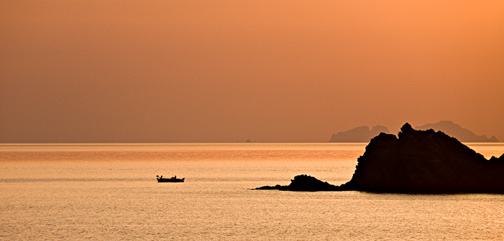
Aegean Fishing. Greece – September, 2005
Canon 5D with 70-300mm f/5.6 DO IS lens @ ISO 400
___________________________________________________________
Rear LCD
When you first see a 5D you may initially not notice that it’s somewhat larger than a 20D, but you definately won’t miss the significantly larger rear LCD. This is a big size improvement over previous Canon screens, and is identical to the screen that Canon has put on the equally new 1Ds MK II. The larger screen not only makes image review superior, but because screen text is also commensurately larger that aspect of camera operation is also enhanced. Clearly (pun intended) this screen is going to become the norm for future Canon cameras.
But before it does so though Canon needs to do something about the screen’s performance in bright conditions, such as in full daylight. While shooting with the 5D in the intense and almost cloudless daylight of Greece I was also taking snapshots with a Sony T7 ultra-thin pocket digicam, which features a transreflective screen, which is, by coincidence, the same size as that on the 5D. While the Sony screen actually remains visible even in direct sunlight, the Canon became so washed out as to be almost unusable. Canon needs to give their future cameras an LCD screen that provides photographers with state-of-the-art technology. The new screen on the 5D and the 1D MK IIn, while larger than on previous models, get a failing grade when it comes to usefulness outdoors.
___________________________________________________________
Settings Registration
For the first time on a Canon DSLR the 5D offers settings registration. What this provides is a settable means to return instantly to just about any combination of camera settings and functions. Kudos to Canon for this addition, but I just have to wonder out loud why it’s taken them so long to offer this very useful feature – one which has has been standard fare on Canon digicams for some time, and which other SLR manufacturers have offered as a matter of course. Also, I have to wonder why, now that it is being offered, it is just limited to a single position. Other cameras offer multiple registration positions, and even the settings knob on the 5D has space available for a half dozen or more additional position, since the amateur oriented setting positions are not present on this moreprooriented camera. A huge space on the dial is currently simply blank.
Which brings us to my favourite rant, the amazingly poor interface design of mirror lockup on Canon cameras. It is buried several menu layers deep in the Custom Function settings, making turning it on and off slow and cumbersome. Now, with the registration function, it can be programmed so that a click to the C position on the top shooting mode dial makes mirror lock up active. But, this begs the question of why there is just one registration position, where each such position likely requires only a few hundred bytes of storage, on a camera that has megabytes of available memory. The single available C position simply doesn’t solve Canon’s awful MLU interface.
So, once more with feeling –Canon, please put mirror lock up on a separate button, or at least as part of the 2 second self timer function. Or, better yet, read the suggestion immediately below.
___________________________________________________________
Direct Print
Which brings us to a button that I find hard to fathom; the new Direct Print button located to the left of the eyepiece. I have to ask – who is this for? On a pro / prosumer camera costing over three thousand dollars, what purpose does this serve? Do Canon’s product planning people really think that the typical owner of a 5D needs a dedicated button to print directly from the camera to a Pixma printer? While useful everyday functions are relegated to buried menu selections, an almost trivial and seldom used capability is given its own dedicated button.
As configured it’s simply an inappropriate waste of interface real-estate. I wish that while Canon was adding an extra button they might have at least allowed us to customize its function, thereby making it much more useful to the majority of advanced users who are the target market for this particular product. Can you say –mirror lock up?
As I’ve asked rhetorically in previous reviews, don’t the camera designers ever ask photographers what they really need and want? Sadly, I guess not.

Gimme a smile ducky. Athens, Greece. September, 2005
Canon 5D with 70-300mm f/5.6 DO IS lens @ ISO 640
___________________________________________________________
Picture Styles
Canon has implemented something which they call Picture Styles, replacing the separate settings which we previous needed for Sharpness, Tone Curve, Contrast, and Color Matrix.
Since I shoot RAW 99.9% of the time this change doesn’t affect me, and so I spent no real time evaluating it. But for those that shoot JPG this is a much more efficient way of working. Expect to see this become the norm on future canon cameras. It’s now also found on the 1D MkIIn.
___________________________________________________________
Batteries
In keeping with the 5D’s design similarity to the 20D and its predecessors, the battery used is a BP-511A. This is a now ubiquitous small Lithium Ion rechargeable, unlike the much larger and heavier (and more expensive) Nickel Metal Hydride batteries used in the Canon 1 Series cameras.
During the two weeks that I initially shot with the pre-production 5D I averaged about 250 shots before the level indicator dropped to 1 bar, after which time it is still usable, but when I typically replace the battery with a fresh one so as not to run the risk of running out of juice at a critical moment. This was with the camera set to 2 minute turn-off, 4 second auto-review, and with a moderate amount of histogram chimping and image review. An IS lens was used most of the time, with IS turned on. The ambient temperature was about 25C (80F). My guess is that these conditions would produce about 350 frames till the battery went completely flat. More with non-IS lenses, and less at colder temperatures.
This number of frames is less than a quarter of the more than one thousand that a 1 Series battery typically provides under similar circumstances. Given these battery’s lighter weight and smaller size I find the trade-off acceptable, but not as good as it should be. Also, it is nowhere near as good as the battery life of the 20D. Whether it’s the larger chip, larger shutter, and something else, or even that this pre-production camera did not have its power capabilities optimized, I can’t say at this point. But it’s a performance aspect that I do hope to quantify in the near future.
Nevertheless three or four of these small batteries should last through even the busiest day, with the extra ones taking up little room or space in ones pocket or bag. Of course with the optional BG-E4 battery grip two batteries are onboard, and so changing is required less frequently.
The charger provided is a single battery CG-580, with a fold-out power plug, obviating the need for a cable (in North America at least). This type of charger is ideal for travel, and well suited to this camera. Overall, with the obvious exception of number of frames per charge, the 5D approach to battery type is preferable to my way of working to the larger and heavier batteries of the 1 Series and their accompanying bulkier charger, even though it means shorter shooting periods between battery changes.
___________________________________________________________
No DEP
Curiously, the 5D does not feature a DEP mode, not even the crippled A-DEP seen on some of Canon’s recent consumer models. Whether or not this is an issue for you will obviously depend on your personal needs and style of working. I have used DEP from time to time, and have found it useful, but I don’t regard its omission as terribly bothersome. Just curious, since it is a feature found till now in one form or another on almost all Canon cameras.
___________________________________________________________
Dust to Dust
Over the past 6 years I’ve shot some 25,000+ frames with Canon DSLRs, every single model from the D30 to the 5D. Dust on the sensor is one of the unavoidable facts of life when working with almost all interchangeable lens digital cameras. For some reason though, the 5D that I was testing seemed to attract more dust than usual.
I would clean the sensor every day, hardly ever changed lenses (the 70-300mm f/5.6 DO IS was my lens of choice on my shoot in the Greek islands, as it has been on every trip I’ve taken since this lens was introduced in late 2004), and yet I’d be surprised each evening on reviewing my files to find dust motes on my images. The conditions weren’t particularly dry, or dusty, but nevertheless I saw somewhat more dust on the sensor than I’ve encountered before. Whether this was some anomaly of locale, or peculiarity of this sample camera I can’t say. I see no reason whatsoever that the 5D should be worse in this regard than previous Canon cameras, but I also would be remiss if I didn’t mention what I observed.
Once I have my own 5D (yes, I have one on order) I’ll be able to follow-up, and hopefully be able to comment whether this was an anomaly or a trend. Time will tell. In the meantime no one should jump to any conclusions based on this single sample report.
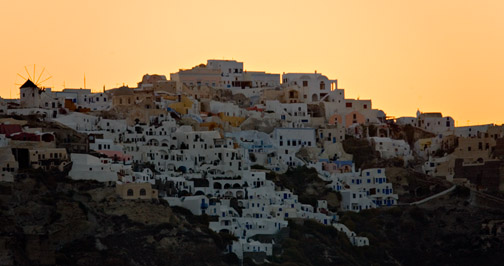
Santorini Dawn. Santorini Greece. September, 2005
Canon 5D with 70-300mm f/5.6 DO IS lens @ ISO 400
___________________________________________________________
The Issue of Full Frame
Nothing will polarize a group of photographers more than a debate about the merits of full-frame vs APS digital. I have no desire to fuel the flames of this argument. But it is clear now, with the 5D, that Canon intends to push full frame 35mm digital downwards into the prosumer, and eventually amateur markets.
They are currently unique among mainstream camera makers in being in control of their own sensor production. Only Matsushita (Panasonic) and Sony produce their own chips. This means that Canon is able to drive prices for large sensor chips downward more quickly than manufacturers that buy their chips elsewhere, and this is reinforced by Canon’s early commitment to CMOS technology, which gives them a tremendous cost edge over those camera makers still using third-party CCDs. Sony is currently the only other camera company designing and making their own CMOS sensors, and so it’s not hard to see how their announced link-up with Konica Minolta to make a DSLR may eventually yield competitive fruit.
This brings us to the core question of full-frame vs APS size (1.5X or 1.6X cropping factor).
As I’ve written before – no one asked for smaller image sensors.Please sir – could I have a smaller negative?They were adopted by camera makers because larger sensors are much more expensive to make. Chip yields fall dramatically the larger the sensor, and the lower the yield, the higher the per unit cost. So to make affordable cameras the manufacturers needed to reduce chip sizes.
This decision carried with it some plusses and some minuses. On the plus size of the ledger were somewhat smaller bodies, due to the ability to use smaller prisms and mirrors and shutters. On the plus side as well were greater perceived reach with long lenses. And, because only the center of the lens’ projected image circle is recorded (the so-called sweet spot), digital’s merciless exposure of lens defects was somewhat ameliorated.
On the debit side of using sub-full-frame sensors were that viewfinders became smaller and dimmer, and wide angle coverage ability was reduced.
I’ve been using the past tense, because over the past 18 months, with the introduction by most camera and third party lens makers of so-called "digital" wide angle lenses this is no longer the issue that it was originally. And cameras like the Nikon D2x show that even one with a 1.5X chip can have a bright and large viewfinder.
But, lets remember that 98% of all the 35mm format lenses ever made, and in photographer’s bags today, are full frame. Yes, the poorer ones will show reduced corner resolution and vignetting when used on a full frame camera. What else is new? Poorer lenses don’t perform as well as better lenses, and chopping off 40-50% of the periphery of the frame will remove the worst bits.
But with good lenses, and with excellent lenses, this is not the case. If these are used the photographer ends up with a larger image because the full usable image being projected by the lens is being utilized and no compromise is being made.
This debate has been mostly academic till now. Those buying Canon 1Ds and 1Ds MKII bodies over the past few years understood the advantages of full frame, and those that didn’t, didn’t. And some that didn’t used the opportunity to fill discussion forums with endless drivel on the subject.
But with the 5D, the writing is on the wall. It would appear to me that Canon intends to drive down the price of full-frame digital SLRs, and by lowering prices they can increase yields, and by increasing yields they will continue to further lower prices.
Yes, there will always be a differential in cost between an APS sized chip and a full-frame chip, and consequently full frame cameras will always be somewhat more expensive, even as digital cameras as a whole continue to reduce in price following a variation on Moore’s Law. But by putting a full-frame sensor into a body that is pretty much from their prosumer mold (read 20D), Canon is telling photographers and their competitors that full frame isn’t just for the well-heeled and pros anymore – it’s going mainstream.
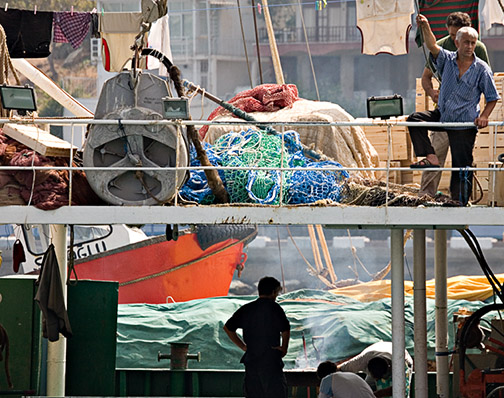
Fisherman. Kusadasi, Turkey. September, 2005
Canon 5D with 70-300mm f/5.6 DO IS lens @ ISO 250
___________________________________________________________
Preliminary Evaluation
As you read what I’ve written above it may strike you that I am a bit negative about aspects of the Canon 5D’s design. While true, this should in no way be interpreted that I don’t appreciate what Canon has accomplished with this ground-breaking camera. It is only because the 5D does so much so very well that I’m comfortable critiquing its few weak points.
The one topic that I have not discussed in any depth thus far is image quality. My time with the 5D coincided with a two week vacation. During that time I took some 1,000 frames with the 5D, but not one of them was made with the purpose of testing, measuring or comparing any aspect of the cameras performance. The photographs taken, and which appear on this page and elsewhere on this site, were produced for the sole purpose of capturing their subject. It also needs to be mentioned again that this was a pre-production camera, and that final shipping cameras may well have different image characteristics.
But even though none of the photographs taken were done as test images, certain conclusions can be fairly drawn from them. The 5D produces images essentially as good as those from the 1Ds MKII – and that’s about as good as it gets. It has slightly lower resolution, of course, but with some theoretical advantages associated with larger pixel size and more recent sensor chip design.
The bottom line then is this – the Canon 5D is an immensely satisfying camera. In a physical size, weight and form factor it is little different than the mainstream of 5 – 8 Megapixel APS sized cameras. But Canon has, with the 5D, provided photographers with a full-frame 35mm of sufficient resolution – 12.8 Megapixel – to meet the print and reproduction size needs of the vast majority of serious photographers. Image quality, whether at normal or at high ISO, is as good as it currently gets.
In this field test I did not have the opportunity of testing image quality aspects such as long exposure noise reduction and the like, but plan on doing so once production cameras become available.
Functionally, the 5D, while not blazing any new ground, provides a set of features and functions that will more than satisfy the vast majority of advanced amateurs and pros. All of this at a price that while by traditional measure is still higher than photographers would like, at least is no longer stratospheric, and dare I write – is almost affordable for many serious photographers.
Yes, the camera has flaws, some almost inexplicable given how easy their fix would be. But, on the whole this is, I believe, destined to be a landmark camera – one which will likely produce a great deal of satisfaction for many photographers, and serve as a price / performance benchmark for the rest of the industry over the next year or two.
September, 2005
Michael Reichmann
You May Also Enjoy...
Narbona Panel
Narbona Pictograph Panel© Miles HeckerCLICK ABOVE IMAGE TO SEE GOOGLE MAP LOCATION SEASONS This pictograph done by an unknown Navajo artist (perhaps Dibe Yazhi
Midnight Rainbow #4: Soft Dawn By Michael Broomfield
FacebookTweet Soft Dawn I trudge down the beach, soft sand. It’s dark when I start, and maybe I use a headlamp and flashlight. Details I

